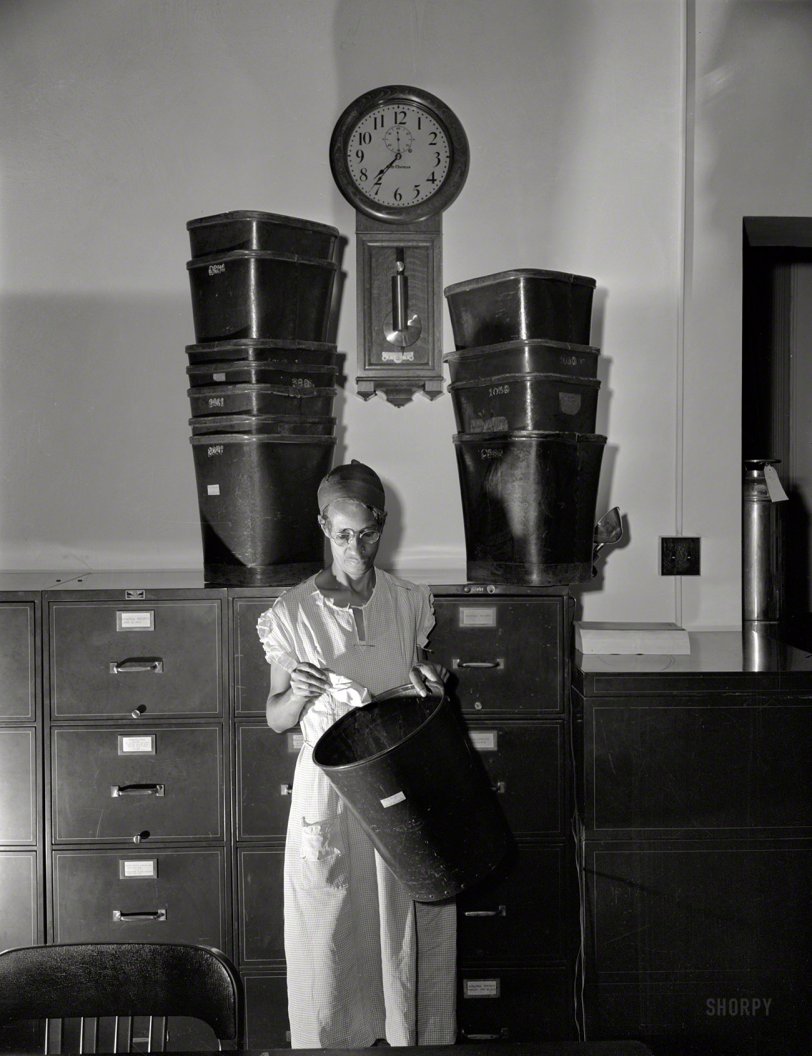


Framed or unframed, desk size to sofa size, printed by us in Arizona and Alabama since 2007. Explore now.
Shorpy is funded by you. Patreon contributors get an ad-free experience.
Learn more.

- Lofty addition
- In 1912
- Keenan Building
- Six years old
- Taken from the P.J. McArdle Roadway?
- It stood only 47 years
- Three track mind
- Incline to the right
- Reach for the sky, 1912 style
- No clean sweep
- Same Job Title, Same Face
- Sadly Lost
- Beautiful ...
- Where you get your kicks
- Aim High
- Pueblo Revival sisters
- Pueblo Neoclassicism
- Milk Man
- Regional dialect.
- Spielberg's inspiration
- Great Photo
- Loaf Story
- Do you still have the Rakes category?
- Could almost be a scene from the 1957 movie 'Hell Drivers'
- The Wages of Fear.
- Conspicuous by their absence
- Got Milk?
- All that aluminum
- No lefties
- Smoke 'em if you've got 'em
Print Emporium
Civil Servant: 1942

August 1942. "Ella Watson, government charwoman who provides for a family of six on her salary of $1,080 per year. She has been a federal employee for 26 years." Label on the wastebasket: "Miss Engle, Div of Recounts." Large format negative by Gordon Parks, Office of War Information. View full size.
The clock
The clock is a Seth Thomas Regulator No. 2, first introduced in the 1860s and produced through 1950, with changes in mechanism, case and dial made over time. The style of the base and the use of Arabic numerals indicate this one was manufactured in 1921 or 1922. Reproductions have been made in more recent years. See this.
Nice catch
Nice catch mountainrev, nice response tterrace, nice community Shorpy.
Not quick enough
Having lurked here for several years, I finally had to register to catch tterrace in an error. As a clock repairman for over 40 years, I know you DO have to wind a weight-driven clock. Sometimes by simply pulling the chain down on the opposite side of the weight pulley. This clock, however, has a crank-shaped key that is inserted in the small hole (about the 4-o'clock position near the second hand circle) and turned to wind the weight cable onto a ratcheted drum, pulling the weight up. It may have been and 8-day clock, but I agree it was probably a daily chore.
Lighting the way
It appears Mr. Parks used a slave flash behind the pile of trash cans on the right, judging from what may be part of a reflector showing. If so, it either didn't fire or was of less intensity than the one bottom left, used to side light the subject's face. He probably wanted to keep the clock visible. Is that a Seth Thomas clock?
Challenging Clock
Winding that clock would be challenging. Not only is it mounted 7 feet high, it's behind file cabinets. Wonder how they did it.
[You don't wind pendulum clocks. - tterrace]
Could you clarify that statement please, tterrace?
[Yes; I was wrong. - t(blush)terrace.]
Pendulums simply regulate clocks. They don't have anything to do with what drives them. This clock has what appears to be a weight in addition to the pendulum. Grandfather clocks typically are driven by weights, which need to be raised periodically. If this clock was driven by a weight, then you're right--it wouldn't need to be wound. But someone would still have to raise the weight regularly, which would be as challenging as winding it, or nearly so. And given the relatively short distance the weight would drop (compared to a grandfather clock), I would imagine it would have to be raised daily or every other day.
























On Shorpy:
Today’s Top 5